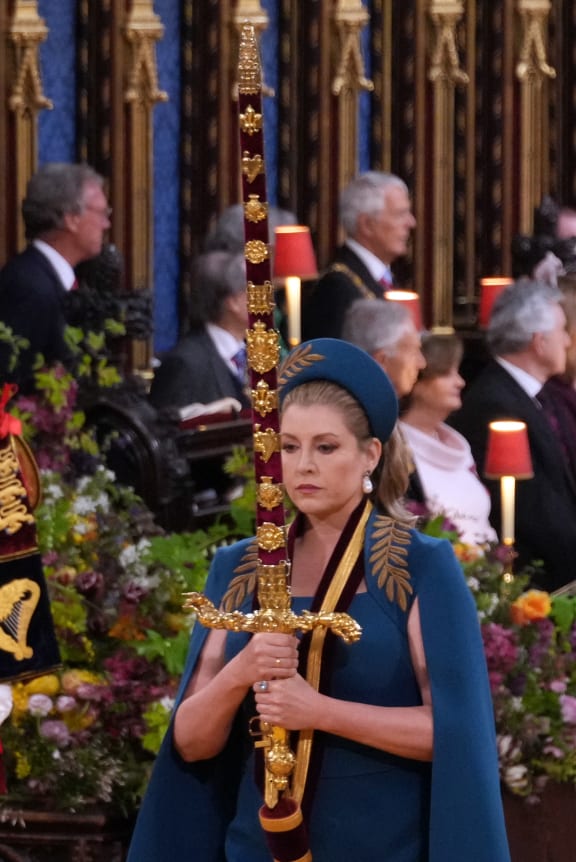King’s coronation roll had one tiny error in 21 metres

By Sean Coughlan, BBC News
King Charles has been presented with a beautifully illustrated record of his Coronation, almost a year after the historic service at Westminster Abbey.
For at least 700 years, monarchs have been given a “coronation roll”.
Stretching for 21 metres, the hand-stitched manuscript was written by calligrapher Stephanie von Werthern-Gill.
And there are no nightmare spelling mistakes, bar a single dot missing over an ‘i’ at the very end.
“Most marvellous illumination work,” said the King, while Queen Camilla said she would need “my specs” to read it.
For the first time, the manuscript did not use any animal skin.
But spare a thought for the calligrapher who wrote it.
This piece of history, like a massive roll of wallpaper, includes 11,500 elegantly inscribed words, using specially made ink.
In an epic achievement of concentration, Stephanie says she kept going for 56 days, without any weekend breaks, determined to keep her rhythm going, phone switched off, her calm sustained by breathing exercises and classical music.
“It was very intense,” she says, but the outcome “feels like a piece of art”.
“All the right spelling?” joked the King, when he looked at the huge roll, which he said “goes on for miles”.
In fact, there was only a single dot missing on a letter i in the hand-stitched pages of copperplate writing, which she’d managed to spot.
The result was shown to King Charles and Queen Camilla at Buckingham Palace on Wednesday, as the King continues his return to duties after more positive news about his ongoing cancer treatment.
This is the official state record of a monarch’s accession and coronation, but it is now as much an artwork as a formal document.
It includes intricate illustrations by Tim Noad, who must soon be the country’s most widely viewed, but least well-credited, artist. Because as well as illustrating this historic document, he is the designer of the King’s cypher, the logo that you will begin to see on new banknotes, public buildings, uniforms and eventually on new post boxes.

The roll records the ceremonies, processions and promises of the Coronation service and shows who was there in the Abbey, particularly those with a ceremonial role, as well as the long lists of royal guests, politicians and overseas representatives.
But not everyone gets a mention.
When the document is finally lodged in the National Archives, there will be no record of Ant and Dec or Katy Perry having been there. And there is not even a hello for Lionel Richie. They have been reduced to a catch-all heading of “Other groups”.
There is also no mention of the protests by anti-monarchists that day.
This coronation roll, the first for 70 years, is intended to be more accessible than its predecessors, so there will be [www.coronationroll.gov.uk an online video version] with recordings of some of those present, such as Leader of the Commons Penny Mordaunt, famous for her sword-carrying skills.
The King and Queen watched the video of themselves at their own coronation. It was like the most upmarket-ever edition of Gogglebox.
Deputy Prime Minister Oliver Dowden, who presented the roll to the King, said: “For the first time, this coronation roll will be digitised – bringing the tradition into the 21st century and giving as many people as possible the opportunity to see it.”
Also for the first time, the official signing of the roll was carried out in front of the cameras, at an event in the College of Arms in London, a venue atmospheric enough to have been used as a location in a James Bond film.
The finished roll, which travelled in a big covering of unhistoric-looking bubble wrap, was carefully signed by the clerk of the crown in chancery, Antonia Romeo.
The original documents, signed by the King on the day in Westminster Abbey, in big black ink, are also now stitched into this long scroll.
The King, who has an occupational interest in signing things, looked at earlier versions of rolls on shiny parchment and said: “You’d have frightful difficulty signing on that.”
The oldest surviving roll is from the coronation of Edward II in 1308. It is in remarkably good condition, considering it had been stashed away in the Tower of London for hundreds of years before later being more carefully protected in the National Archives.
Until this latest 2024 roll, all the previous versions had been written on materials made from animal skin. But this time the roll has been recorded on high-quality paper, reflecting other modern changes such as the coronation oils also being made animal-free.
Dr Sean Cunningham, from the National Archives, said that rolls once had a very practical political purpose. It was documentary proof of the legitimacy of a reign, with evidence to show rebellious nobles about the promises they had made.
“In medieval times when the crown was contested a lot more, these were important records of the authority of an incoming monarch. It’s about the loyalty and allegiance to that new king,” says Dr Cunningham.
The rolls have also been crib sheets for how to run a coronation. Charles II used them to find details “to add lustre and splendour to the solemnity” of his crowning in 1661. Medieval rolls were consulted for James II’s coronation in 1685.
The early rolls were written in Norman French and Latin, with the first version fully in English not until 1820 and the coronation of George IV.
Queen Camilla raised the question: “Why are they called rolls not scrolls?”, and the answer was because of the Rolls Chapel where they were kept.
The roll for King Charles III, an exercise in craftsmanship as much as record-keeping, is expected to go on public display, before being stored in the National Archive, so that future generations can unroll this moment of history.
– This story was first published by the BBC.
According to the news on Radio New Zealand




